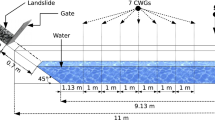Abstract
Many landslides can often be characterized as a sort of landslides which move rapidly like flowing fluid and thus have a long run-out. They usually cause large damage and casualties especially when they are trigged by an earthquake or heavy rain. Numerical simulations of flow-like landslides are difficult due to the existence of free surface and large flow deformations. In this work, the smoothed particle hydrodynamics (SPH) method is applied to model two- and three-dimensional flow-like landslides for the run-out analysis. This is because SPH method is a meshfree, Lagrangian particle method, and is believed to be superior to conventional numerical methods in treating free surfaces, moving interfaces, and large deformations; hence, it is ideal in describing the complex fluidization characteristics in flow-like landslides. In this paper, a Bingham flow model and Navier–Stokes equations are incorporated into the SPH frame work, in which fluids are discretized by flow particles, and 3D terrain topography from GIS is represented by surface (or solid wall) particles. An improved SPH method is first applied to simulate the whole run-out processes of three flow-like landslides, which were triggered by Wenchuan earthquake that occurred in China in 2008. The effectiveness of the improved SPH method in modeling flow-like landslides is demonstrated by the good agreement of the 3D profile simulation results obtained from the present SPH simulation with field observation and results from other open sources. The SPH method is then used to predict the run-out area of Jinpingzi landslide.










Similar content being viewed by others
References
Cascini L, Cuomo S, Pastor M, Sorbino G, Piciullo L (2014) SPH run-out modelling of channelised landslides of the flow type. Geomorphology 214:502–513
Chen JK, Beraun JE (2000) A generalized smoothed particle hydrodynamics method for nonlinear dynamic problems. Comput Method Appl Mech Eng 190:225–239
Colagrossi A, Landrini M (2003) Numerical simulation of interfacial flows by smoothed particle hydrodynamics. J Comput Phys 191:448–475
Dai Z, Huang Y, Cheng H, Xu Q (2014) 3D numerical modeling using smoothed particle hydrodynamics of flow-like landslide propagation triggered by the 2008 Wenchuan earthquake. Eng Geol
Duncan JM (1996) State of the art: limit equilibrium and finite-element analysis of slopes. J Geotech Eng 122:577–596
Eberhardt E, Stead D, Coggan JS (2004) Numerical analysis of initiation and progressive failure in natural rock slopes—the 1991 Randa rockslide. 41(1):69–87
Gingold RA, Monaghan JJ (1977) Smoothed particles hydrodynamics: theory and application to non-spherical stars. Mon Not R Astron Soc 181:375–389
Hadush S, Yashima A, Uzuoka R (2000) Importance of viscous fluid characteristics in liquefaction induced lateral spreading analysis. Comput Geotech 27(3):199–224
Hammouri NA, Malkawi AIH, Yamin MMA (2008) Stability analysis of slopes using the finite element method and limiting equilibrium approach. Bull Eng Geol Environ 67:471–478
Hu XW, Huang RQ, Shi YB, Lv XP, Zhu HY, Wang XR (2009) Analysis of blocking river mechanism of Tangjiashan landslide and dam-breaking mode of its barrier dam. Chin J Rock Mech Eng 28(1):181–189 (in Chinese)
Huang Y, Dai Z (2014) Large deformation and failure simulations for geo-disasters using smoothed particle hydrodynamics method. Eng Geol 168:86–97
Huang RQ, Li WL (2009) Analysis of the geo-hazards triggered by the 12 May 2008 Wenchuan Earthquake, China. Bull Eng Geol Environ 68(3):363–371
Huang Y, Dai ZL, Zhang WJ, Chen ZY (2011) Visual simulation of landslide fluidized movement based on smoothed particle hydrodynamics. Nat Hazards 59:1225–1238
Huang Y, Zhang WJ, Xu Q, Xie P (2012) Run-out analysis of flow-like landslides triggered by the Ms 8.0 2008 Wenchuan earthquake using smoothed particle hydrodynamics. Landslides 9:275–283
Liu GR, Liu MB (2003) Smoothed particle hydrodynamics: a meshfree particle method. World Scientific, Singapore. ISBN 981-238-456-1
Liu MB, Liu GR (2006) Restoring particle consistency in smoothed particle hydrodynamics. Appl Numer Math 56:19–36
Liu MB, Xie WP, Liu GR (2005) Modeling incompressible flows using a finite particle method. Appl Math Model 29:1252–1270
Liu MB, Shao JR, Chang J (2012) On the treatment of solid boundary in smoothed particle hydrodynamics. Sci China Technol Sci 55(1):244–254
Lucy LB (1977) A numerical approach to the testing of fusion process. Astron J 82:1013–1024
McDougall S, Hungr O (2004) A model for the analysis of rapid landslide motion across three-dimensional terrain. Can Geotech J 41(12):1084–1097
Morris JP, Fox PJ, Zhu Y (1997) Modeling low Reynolds number incompressible flows using SPH. J Comput Phys 136(1):214–226
Pastor M, Haddad B, Sorbino G, Cuomo S (2009) A depth-integrated, coupled SPH model for flow-like landslides and related phenomena. Int J Numer Anal Meth Geomech 33:143–172
Scavia C (1995) A method for the study of crack propagation in rock structures. Geotechnique 45(3):447–463
Shao SD, Edmond YM (2003) Incompressible SPH method for simulating Newtonian and non-Newtonian flows with a free surface. Adv Water Resour 26(7):787–800
Shao JR, Li HQ, Liu GR, Liu MB (2012) An improved SPH method for modeling liquid sloshing dynamics. Comput Struct 100:18–26
Sun P, Zhang YS, Shi JS (2009) Analysis on the dynamical process of Donghekou rapid long runout landslide-debris flow triggered by great Wenchuan earthquake. In: Proceedings of the international symposium and the 7th Asian regional conference of IAEG, Chengdu, pp 902–909
Uzuoka R, Yashima A, Kawakami T, Konrod JM (1998) Fluid dynamics based prediction of liquefaction induced lateral spreading. Comput Geotech 22(3/4):234–282
Yin YP, Wang FW, Sun P (2009) Landslide hazards triggered by the 2008 Wenchuan earthquake, Sichuan, China. Landslide 6(2):139–152
Author information
Authors and Affiliations
Corresponding author
Electronic supplementary material
Below is the link to the electronic supplementary material.
Rights and permissions
About this article
Cite this article
Hu, M., Liu, M.B., Xie, M.W. et al. Three-dimensional run-out analysis and prediction of flow-like landslides using smoothed particle hydrodynamics. Environ Earth Sci 73, 1629–1640 (2015). https://doi.org/10.1007/s12665-014-3513-1
Received:
Accepted:
Published:
Issue Date:
DOI: https://doi.org/10.1007/s12665-014-3513-1




